Related Research Articles

Bushrangers were originally escaped convicts in the early years of the British settlement of Australia who used the bush as a refuge to hide from the authorities. By the 1820s, the term had evolved to refer to those who took up "robbery under arms" as a way of life, using the bush as their base.
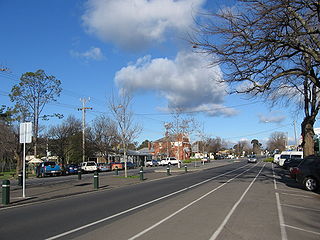
Heathcote is a town in central Victoria, Australia, situated on the Northern Highway 110 kilometres north of Melbourne and 40 kilometres south-east of Bendigo via the McIvor Highway. Heathcote's local government area is the City of Greater Bendigo and it is part of the federal electorate of Bendigo and the state electorate of Euroa. At the 2021 census, Heathcote had a population of 2,962.
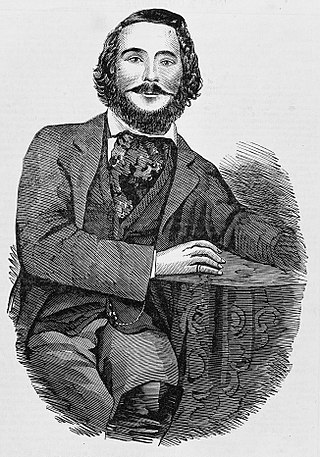
Frank Gardiner was an Australian bushranger who gained infamy for his lead role in the a robbery of a gold escort at Eugowra, New South Wales in June 1862. It is considered the largest gold heist in Australian history. Gardiner and his gang, which included bushrangers Ben Hall, John O'Meally, Johnny Gilbert, Henry Manns, Alexander Fordyce, John Bow and Dan Charters, made off with a pile of cash and 77 kilograms of gold, worth about $10 million today. After several years in prison for the robbery, Gardiner was exiled and moved to the United States, where he died in or about 1882.
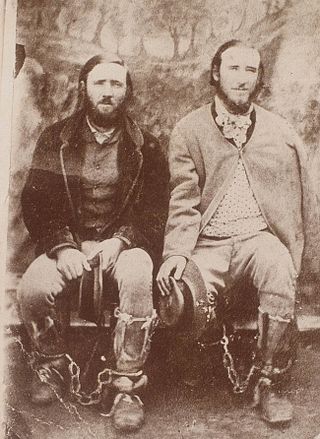
Brothers Thomas and John Clarke were Australian bushrangers from the Braidwood district of New South Wales. They committed a series of high-profile crimes which led to the enacting of the Felons' Apprehension Act (1866), a law that introduced the concept of outlawry in the colony and authorised citizens to kill bushrangers on sight. Thomas was proclaimed an outlaw on 31 May 1866.

William Westwood, also known as Jackey Jackey, was an English-born convict who became a bushranger in Australia.

Mia Mia is a locality of Central Victoria, Australia, 119 kilometres (74 mi) north of Melbourne and 56 kilometres (35 mi) south of Bendigo. It is largely an area of broadacre farms raising cattle and sheep. It is a part of the Heathcote wine region Wine District and a number of vineyards have been established in the area, most notably producing Shiraz grapes. Its local government areas are the City of Greater Bendigo and Shire of Mitchell, Mia Mia is part of the Federal Electorates of Bendigo and McEwen and it is in the state electorate of Euroa. In 2011, it had a population of 265.

John Donahue, also spelled Donohoe, and known as Jack Donahue and Bold Jack Donahue, was an Irish-born bushranger in Australia between 1825 and 1830. He became part of the notorious "Wild Colonial Boys".
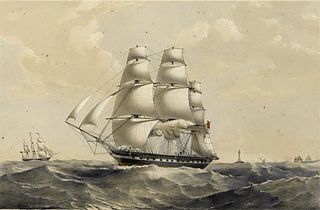
Madagascar was a large British merchant ship built for the trade to India and China in 1837 that disappeared on a voyage from Melbourne to London in 1853. The disappearance of Madagascar was one of the great maritime mysteries of the 19th century and has probably been the subject of more speculation than any other 19th century maritime puzzle, except for the Mary Celeste.
Francis McNeiss McNeil McCallum was a Scottish-born Australian notorious bushranger during the early part of the Victorian Gold Rush in Australia.

It is widely believed that in the tumultuous years following the Victorian gold rush that a number of robberies by armed bandits, known in Australia as bushrangers, took place on St Kilda Road, then a track through the scrub from the city to the seaside settlement of St Kilda. However only two events are recorded, and only one took place on today's St Kilda Road.
The Gardiner–Hall Gang was an informal group of bushrangers who roamed the central west of the Colony of New South Wales, Australia in the 1860s. Named after leaders Frank Gardiner and Ben Hall, the gang was involved in numerous shootouts and robberies, including Australia's largest ever gold robbery, at Eugowra Rocks. The gang had its origins in 1861; its demise came with the execution of John Dunn in 1866.

Henry Beresford Garrett (c. 1818 – 3 September 1885) was a habitual criminal who served prison sentences in England, Tasmania, Victoria and New Zealand. Born Henry Rouse, he used a number of aliases including 'Long Harry' and Henry Beresford Garrett.

John O'Meally, known informally as 'Jack' O'Meally, was an Australia bushranger. He was recruited to join the Gardiner–Hall gang to carry out the gold escort robbery near Eugowra in June 1862, Australia's largest gold theft. O'Meally became a member of the group of bushrangers led by Johnny Gilbert and Ben Hall, which committed many robberies in the central west of New South Wales. Considered to be the most violent and hot-headed of the group, O'Meally was probably responsible for two murders during this time. The gang managed to evade the police for long periods and became the most notorious of the bushranging gangs of the 1860s. Jack O'Meally was shot and killed during an attack on the 'Goimbla' station homestead in November 1863.

Thomas Frederick Lowry, better known as Fred Lowry, was an Australian bushranger whose crimes included horse theft, mail-coach robbery, prison escape, and assault with a deadly weapon. Lowry briefly rode with the Gardiner–Hall gang, but soon afterwards formed his own gang with John Foley.

John Foley was a bushranger and associate of Fred Lowry. In July 1863 they robbed several mail coaches, including the Mudgee mail robbery which netted £5,700 in bank-notes. Foley was captured several weeks later with bank-notes from the Mudgee mail in his possession. He was tried at Bathurst and sentenced to fifteen-years hard labour. Foley was released in 1873; he settled in the Black Springs district near Oberon and led a respectable life until his death in 1891.

Lawrence Cummins, known informally as Larry Cummins, was a bushranger who operated primarily in the districts surrounding the Abercrombie River. In July 1863 he participated in the Mudgee mail robbery led by Fred Lowry and John Foley. Soon afterwards Cummins and his younger brother John carried out several robberies. They were identified and John Cummins was apprehended; he was accidentally shot and killed while being escorted by police constables. Three weeks later Cummins was captured with his associate Lowry, in an encounter with the police which resulted in Lowry’s death. Cummins was sent to Berrima Gaol in late 1863, from where he escaped in November 1866 with another prisoner. From December 1866 to April 1867 Cummins carried out a series of audacious robberies. In April, during an attempted robbery of Webb's store on the Fish River in company with John Foran, he received a wound in the face from birdshot. He was captured soon afterwards and sentenced to thirty years hard labour and sent back to Berrima Gaol.
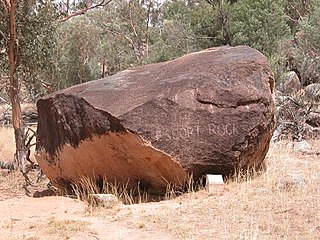
Escort Rock is a heritage-listed geological formation at Escort Way, Eugowra, Cabonne Shire, New South Wales, Australia. It is one of a group of historic sites labelled the Ben Hall Sites for their association with bushranger Ben Hall, along with Ben Hall's Death Site, the Bushranger Hotel, Cliefden, the Grave of Ben Hall and Wandi. It was added to the New South Wales State Heritage Register on 8 October 2010.

Gold Escorts were common across Australian goldfields, transporting mined and processed material from mines to banks and mints across the country.

Francis Augustus ("Frank") Hare (1830–1892) was a British pioneer settler and police superintendent in the colony of Victoria, best known for his role in the capture of the notorious bushrangers known as the Kelly gang at the town of Glenrowan in north-west Victoria.
References
- Blake, Gold Escorts in Australia, Rigby, 1978.
- J. O. Randell, McIvor, published by the author, East Melbourne, 1985, pp. 116–117.
- R. H. Horne, Australian Facts and Prospects, Smith, Elder & Co., Cornhill, London, 1859
- William Howitt, Land, Labor and Gold, or Two Years in Victoria, Boston, Ticknor & Fields, 1855
- William Kelly, Life in Victoria, 1853 and 1858 Vol. II, pp. 12–14
- Charles D Ferguson, The Experiences of a Forty-niner during Thirty Four Years' Residence in California and Australia, Cleveland, Ohio, 1888.
- Charles White, History of Australian Bushranging